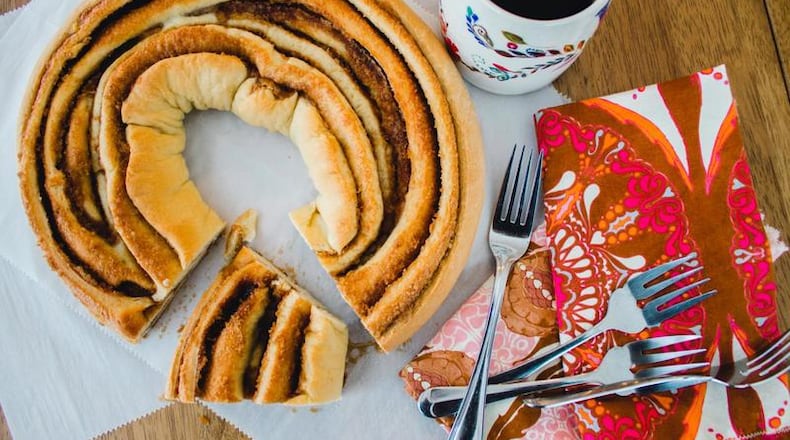In Saving Southern Recipes, Southern Kitchen’s Kate Williams explores the deep heritage of Southern cooking through the lens of passed-down, old family recipes.
Stop into any bakery near New Orleans this time of year and you'll likely be greeted by a flood of purple, yellow and green ring-shaped cakes, sparkling with sprinkles and displayed with brightly colored beads, masks, and doubloons. Yes, it's King Cake season, and with it comes plenty of tongue-dying food coloring, plastic babies and way too much sugar.
Said to honor the three kings, or wise men, who visited the baby Jesus on the 12th day of Christmas, versions of King Cakes have been eaten by Christians since at least the Middle Ages. According to Scientific American, this tradition was picked up not from ancient Christian elders, but from cakes eaten for the winter solstice celebration of Saturnalia:
Cakes were made to celebrate the harvest and, according to Larousse Gastronomique, "During the Saturnalia the "king of the day" was chosen by lot, using a bean concealed in a galette. It was only in the Middle Ages that this cake ceremony began to be associated with the festival of Epiphany."
As the tradition was adopted by Christians, the bean became symbolic of the baby Jesus (or a king, depending on who you ask), and, by the 1300s, the cake had become popular throughout France. While they were originally eaten just around the holiday of Epiphany, king cakes gradually became a season-long treat enjoyed up until the beginning of Lent.
It's easy to forget that these cakes didn't always come in varying shades of neon; they varied depending on the region from which they came. Northern French king cakes are, at least now, more often made from puff pastry and filled with an almond-sugar mixture. Further south in France, and into the Basque region of Spain, king cakes are made from brioche-like dough and filled with cinnamon and spices. It is this Southern-style cake that made its way to New Orleans in 1718.
Over time, this simple cake adpoted the more raucous nature of the pre-Lenten season, gaining more fillings and more frostings with each passing year. In the mid-20th century, the bakery McKenzie's popularized the practice of hiding a plastic baby figurine inside the cake, and today, many bakeries offer dozens of flavors of the cake, including cakes as elaborate as praline crunch, and the Elvis-inspired bacon, chocolate and banana. Decorations are as simple as a dusting of colored sugar, or as elaborate as multicolored metallic glaze.
Southern Kitchen contributor and cookbook author Anne Byrn included two king cake recipes in her book, "American Cake," one of which is similar to that original Basque cake. The second, slightly easier cake, is made with store-bought puff pastry, a common shortcut that delivers a buttery dessert in a fraction of the time. Still, if you're not one for all that sugar (ahem, me, ahem), it's best to stick with the older version, which, even if fairly time consuming, isn't difficult to make. You don't even need a stand mixer to knead the brioche dough, and the striking stripes on top are achievable even for beginner bakers.
Get the recipe for Cinnamon Swirl King Cake here.
Keep Reading
The Latest
Featured



